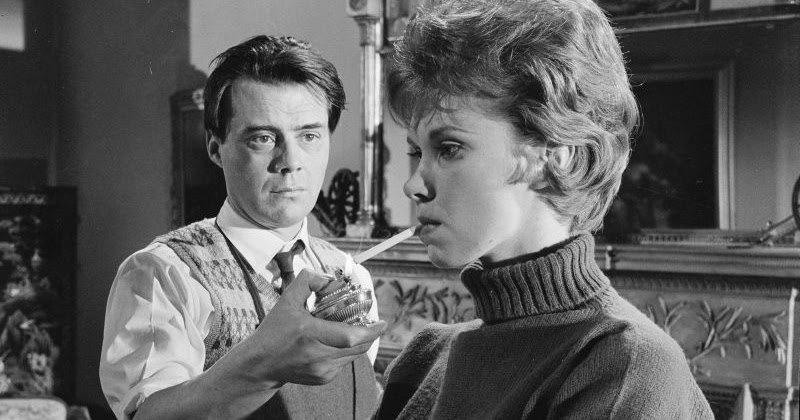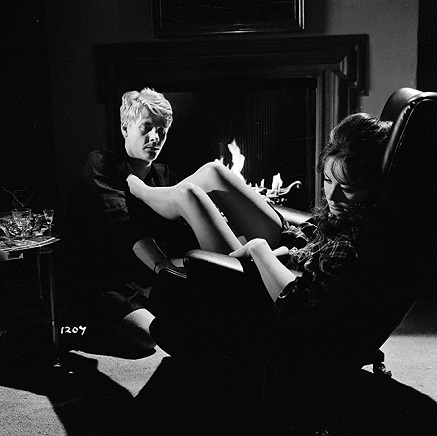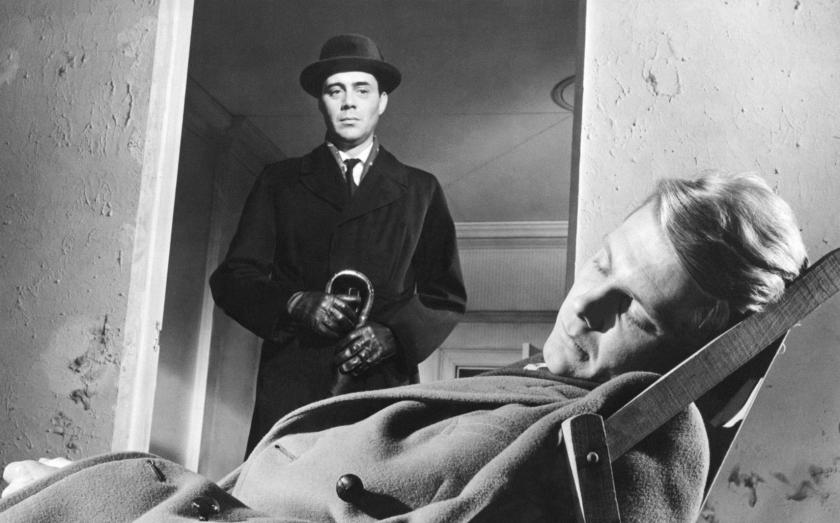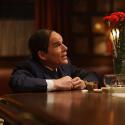Switching between upstairs and downstairs makes your soul melt, in this first of three Joseph Losey/Harold Pinter films, a savage class satire filmed in the freezing winter of 1963.
Hugo (Dirk Bogarde) is the obsequious, insinuating butler who comes to stay with minor, lounging young aristo Tony (James Fox) at his new Chelsea pad. The pricey house is soggy with rot when Hugo arrives, though louche Tony, declaring himself “cosy” with his bed of newspapers and three-bar fire, sees nothing amiss. Hugo’s dubious, papier-mâché provenance as a gentleman’s gentleman is clear from his first appearance beneath a Thomas Crapper Sanitary Engineers sign, lending a queasy horror film cast to his presence, even before Pinter’s usual male power struggles begin. The Servant is partly a proto-home invasion film, deepened with symbiotic, hysterical class terror and need.
American director Losey was already deep into his European exile from McCarthy’s anti-Red witch-hunts, which deployed his film noir pedigree in profound art-house terrain. He was, cast-members agree in the extras on this Vintage release, “paranoid... unhappy”, “not an optimistic person”, and “very serious... driven”. Pinter proved an ideal collaborator (they followed The Servant’s great success with Accident and The Go-Between) not only because of his own stark seriousness, but also his leavening English black humour and sense of deadly farce. Bogarde is the third element in The Servant’s enduring cult, as Rank’s Fifties matinee idol becomes camply punctilious, his eyes’ hooded assessment calculating for advantage and survival, his design advice of “Mandarin orange and fuchsia” as much guesswork as gay sensitivity. Privately puffing his cheeks, he suggests a world of bitter disappointment, viciously expressed when he calls a schoolgirl a “little fucking bitch” (the taboo curse spoken and almost heard). The Servant would launch Bogarde, like Losey, into a second act of European art-house profundity. But, critic Matthew Sweet suggests in an illuminating extra, The Servant “soaked up the anxieties and fears of the people who made it”, and Bogarde almost quivers with edgy desperation.
Bogarde is the third element in The Servant’s enduring cult, as Rank’s Fifties matinee idol becomes camply punctilious, his eyes’ hooded assessment calculating for advantage and survival, his design advice of “Mandarin orange and fuchsia” as much guesswork as gay sensitivity. Privately puffing his cheeks, he suggests a world of bitter disappointment, viciously expressed when he calls a schoolgirl a “little fucking bitch” (the taboo curse spoken and almost heard). The Servant would launch Bogarde, like Losey, into a second act of European art-house profundity. But, critic Matthew Sweet suggests in an illuminating extra, The Servant “soaked up the anxieties and fears of the people who made it”, and Bogarde almost quivers with edgy desperation.
Though Pinter’s concern with faltering machismo has led to accusations of misogyny, the sheer heat of sexual conflict, as with Graham Greene’s similarly self-centred masculinity, permits potent, unvarnished female roles. Wendy Craig (pictured above with Bogarde) makes Tony’s girlfriend Susan an equal rival to Hugo, wielding icy class power when she’s not curled in a warm coital glow as Cleo Laine plays on the turntable.
The arrival of Hugo’s “sister” Vera from Bolton meanwhile lets 18-year-old Sarah Miles (pictured below with Fox) overcome Tony with sensual, studied innocence (Miles’ choice; Losey, fresh from Jeanne Moreau’s prostitute unmanning Stanley Baker in Eva, wanted a vamp). The quickening drum-beat of a dripping tap and a close-up of Miles murmuring, “Under the what, sir?” account for much of The Servant’s box-office success. Its trailer, included here, sold it as a sexy, taboo-busting kitchen-sink film like Room at the Top, and the Bolton cuckoos in posh Tony’s nest are also intruders from British cinema’s New Wave; Sweet suggests Bogarde’s vague Northern accent impersonates Tom Courtenay, and he had been stopped by Rank from playing Albert Finney’s iconic anti-hero in Saturday Night and Sunday Morning. When Tony and Susan unexpectedly creep in below stairs one night, their horror at Hugo and Vera’s capering upstairs has a lurching, fairytale sickness. Tony’s husky, failed shout to “get out” completes his social evisceration. The house was rotting when he got it, and, as he finds he can’t do without Hugo’s sadistic attentions, Tony too erodes. He ends in a chiaroscuro dance of shadows and light, numbly sozzled and surrounded by his ancestors’ portraits. He could be the Duke of Wellington’s last offspring, losing the Sixties' battle.
When Tony and Susan unexpectedly creep in below stairs one night, their horror at Hugo and Vera’s capering upstairs has a lurching, fairytale sickness. Tony’s husky, failed shout to “get out” completes his social evisceration. The house was rotting when he got it, and, as he finds he can’t do without Hugo’s sadistic attentions, Tony too erodes. He ends in a chiaroscuro dance of shadows and light, numbly sozzled and surrounded by his ancestors’ portraits. He could be the Duke of Wellington’s last offspring, losing the Sixties' battle.
The comparison with Fox’s other great role in Performance (1970), as the East End gangster who merges into Mick Jagger’s West London rock star in another claustrophobic townhouse, and Fox’s own seeming subsequent disintegration as he quit acting for Christian evangelism, is hugely suggestive. Fox is witty and sharply intelligent in a long interview with Richard Ayoade (from an earlier reissue, like the late Sarah Miles’ fizzing 2012 memories). “He just wanted me to be me,” he disarmingly says of Losey’s direction of him, aged 23. Fox’s face “lent itself to that kind of destruction”, Losey confirms in a contemporary interview.
The extras are copiously excellent, ranging from a short documentary on the film’s London locations to a blunt interview with a combative Pinter (including a glimpse of The Homecoming’s original production).















Add comment